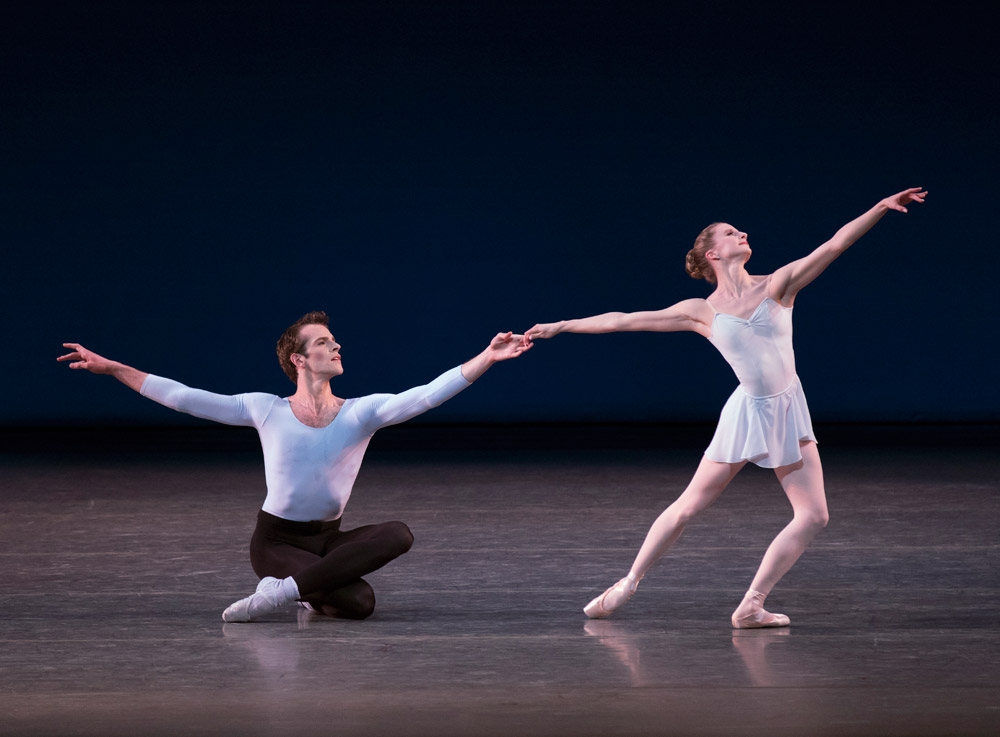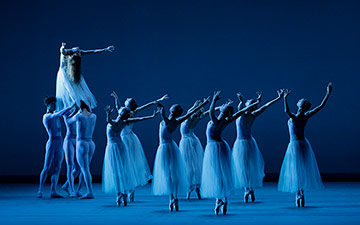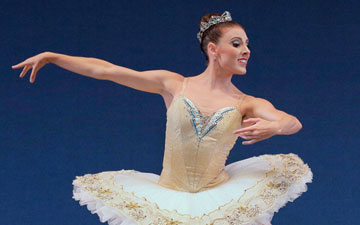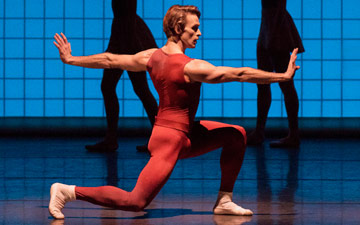
© Paul Kolnik. (Click image for larger version)
New York City Ballet
Balanchine Black and White Festival
Black and White II: Apollo, Agon, Duo Concertant, Symphony in Three Movements
New York, David H. Koch Theater
6 May 2015
www.nycballet.com
Debuts x 3
There were three débuts at New York City Ballet last night: Zachary Catazaro in Apollo, Russell Janzen in Duo Concertant, and Lauren King in the role I think of as the “jumping girl” in Symphony in Three Movements. There were some nerves on display, particularly in Apollo. Catazaro got off to an energetic start – perhaps too energetic – and dropped, no, flung his lute to the floor. It must have taken everything he had not to break into tears at that moment. But he went on, as dancers do. His Apollo is still a bit rough around the edges. The positions aren’t as clear as they should be, and the transitions are a little jumpy, but, but… There is still something there. Catazaro is certainly god-like enough: tall, handsome, with long lines and a striking profile. He seems cut out for the part. So the first battle is won. And he’s an exciting partner – he really looks at the women he dances with, and responds to their touch. At this performance he had a lovely rapport with his frisky, hyper-feminine Terpsichore, Sterling Hyltin. He’s a theatrical dancer, too. And he has a glorious jump: big, soaring, heavy, broad, heroic. And a nice plié at the end. His Apollo has the wildness of a young colt, and that’s not necessarily a bad thing. But he lacks confidence. Maybe that will come.
Janzen, on the other hand, betrayed no nerves, except perhaps at the very start of Duo Concertant, when he and Hyltin stood behind the piano, “listening” to the musicians. It’s an awkward moment, hard to pull off naturally, and Janzen had a slightly fixed look in his eye. But as soon as the dancing began, pouf, the lack of focus disappeared. Janzen has a maturity that is atypical in the company – he moves with a certain gravity, like an adult, with adult worries and sorrows. He let Hyltin pull him into the dance, almost resisting for a moment, a nice touch. It implied a human interaction: eagerness, hesitation, acquiescence. And then, once he began to dance, he displayed an unusually sensitive musicality. I noticed the staccato movements of his arm as it ticked the hours in the opening sequence of the dance, the sharpness of his footwork. His beats are crystal clear. And he has a quietness when he dances, an introspection that never calls attention to itself but nevertheless imbues what he does with a kind of weight. Actually, he might make a good Apollo.

© Paul Kolnik. (Click image for larger version)
Lauren King as the Three Movements “jumping girl” is in a less central role than either of the above – certainly less layered or complex. In her bright pink leotard, the woman rushes onstage and, as the pianist pokes out a syncopated tattoo of chords on the piano, she jumps, jumps, jumps, in competition with her male counterpart (Atonio Carmena). They tuck their legs under them in the air, turning their bodies into bouncing balls, projectiles shot out of a canon. Or kids one-upping each other in a game. King is a sprightly, bright dancer, so the part suits her, even though, truth be told, she doesn’t have the biggest jump. But all in all, it’s a happy marriage of dancer and dance.
Tiler Peck danced the stylized, faintly Chinese-tinged pas de deux that follows, with Amar Ramasar. We don’t often see her in these abstract leotard roles, and in fact there is something almost too soft, too rounded and naturally high-spirited about her style in Symphony. But she’s such an intelligent dancer; she pulls it off by bending the pas de deux to her strengths, subverting its abstraction and turning it into a showcase for her musicality and her lush, bending-and-twisting approach. She wins you over withe her physical understanding of the role. Experience – and a point of view – trumps easy categorization.

















You must be logged in to post a comment.